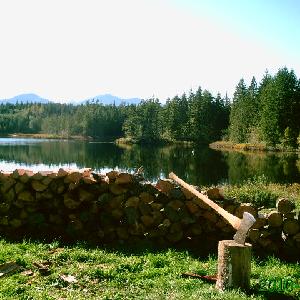
Keeping It Small and Simple by iWENN
Pitch
Build simplistic wood splitters/cutters using old car parts to allow for safe wood reduction to cook stove size. Small wood dries faster!
Description
Summary
Many woodstove users in the N. Cascades are beginning to use small scale electric/hydraulic wood splitters which makes it easy to reduce a log down to small dimensions typically needed for wood stoves. This smaller dimension wood dries much faster and the splitters also helps prevent accidental hand/foot injuries typically experienced from using traditional axes for wood size reduction down to the smallest size. Splitting wood down to the smallest size is when many hand injuries occur!!
A number of highly simplistic foot powered wood splitter designs can be found on the Internet. One of the simplest design which has a retail price in the price range called for in this contest can be found here.
Using basic engineering designs for a splitter/cutter, which can be mounted upon the stove which has already been distributed or stand alone units, would be straight forward and the units can be made locally with basic welding gear, standard steel stock, and car hood springs.
The image below is what I do for fun during the summer months in my backyard as I cook and heat with firewood. Over the last 20 years I have worked with more than 5 cords (10 tons) of fire wood per year. Getting the wood to small cookstove size is the real key to using green (wet) cooking wood (IMMHO).
Also, as the judges realize, using wet wood for cooking and heating is as much a process than a technical issue as using today's fire to dry tomorrow's wood is a common practice. Getting the 'small stuff' down to even smaller size would help the traditional drying effort. It's even possible to use the energy of children, such as in the water well powered by a marry-go-round, to provide a village with a large stock of reduced wet wood.
The following form fields are short on content as this summary basically is the proposal. I believe in keeping it simple and small.
Category of the action
Adaptation
Who will take these actions?
The engineering design(s) simply needs to use mechanical leverage advantage and work in a stable way with the stove. Separate systems are possible and would allow the splitter/cutters to be taken into the field as an aid to wood gathering.
What are other key benefits?
What are the proposal’s costs?
I would absolutely love spending time in Columbia working with rural communities on this issue. However the cost of my trip could be best used to get equipment into the field.
In brief, the cost of getting this idea into the field is rather low.
Time line
Mid summer could see the first units in use.